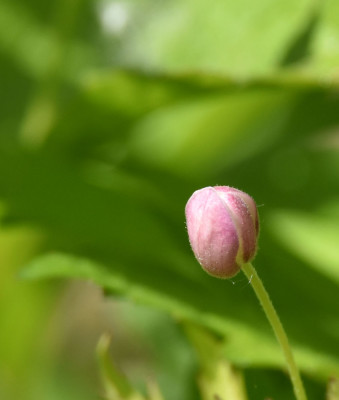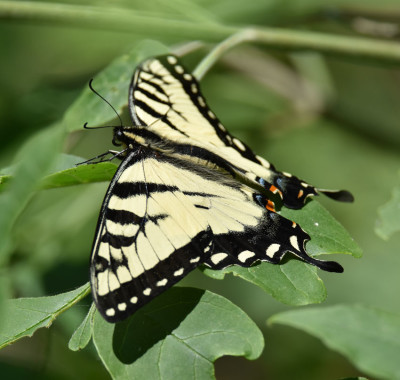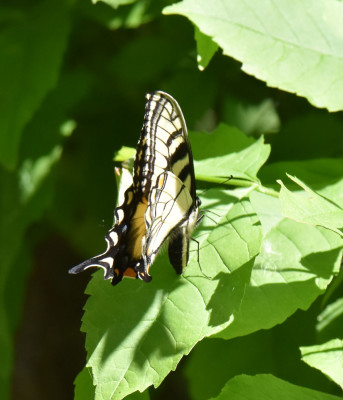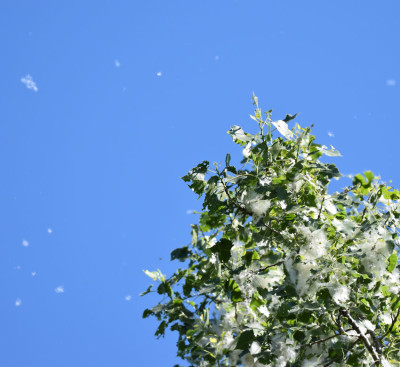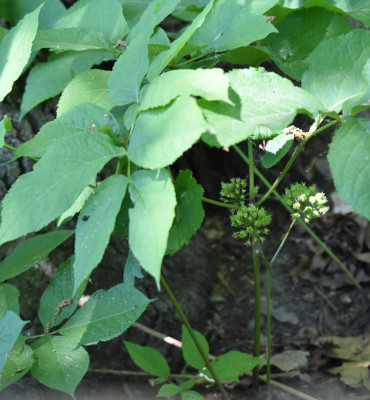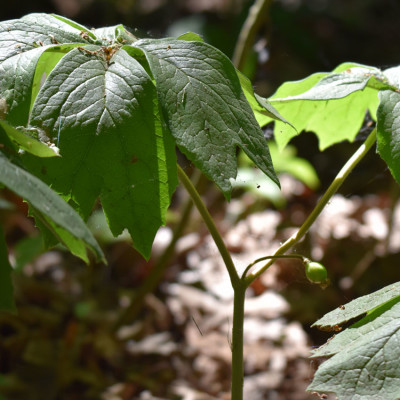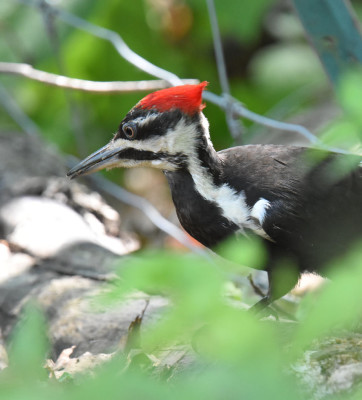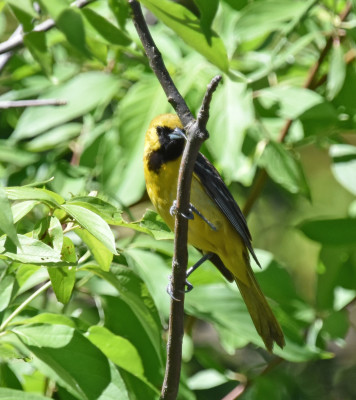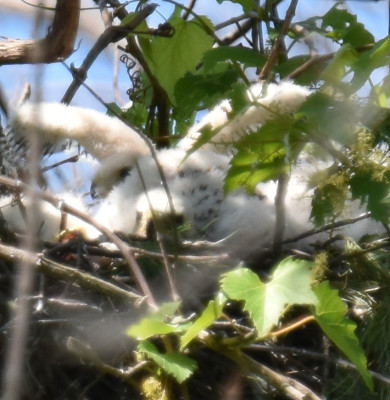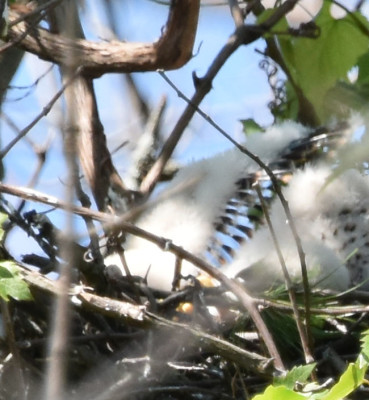When people see me walking around the parks with my over-sized camera, I often get asked if I’m looking for birds. Sometimes I say yes, but when I’m more honest I say yes but also flowers and butterflies and frogs and fish and anything that will stay still. I’m interested in basically everything which is very convenient as it means I never have a walk where I don’t find something intriguing. My Dad gave me a t-shirt when I was a teen that said “Nature Nut” on it and it’s still accurate today.
My recent ramble through the Rattray included some great glimpses into the lives of birds. It also left me wondering whether a dragonfly that zoomed off before I could get a closer peek was a female or juvenile Common Whitetail, or a 12-Spotted Skimmer, or something else again. I noticed a flowering plant that by its abundance and proximity to the path I think is probably another alien, possibly invasive, that I haven’t noticed before. I saw the Trilliums going to seed and wondered if ants really do carry their seeds underground to get at the covering on them and accidentally plant them. I saw a ladybug and several interesting flies and wondered when the Hairstreak butterflies will be out. There were 7 adult Wood Ducks in the pond beside the lagoon in the marsh making me wonder if any had families this year or not. Then I saw and regretted that another person had casually stepped on a Mourning Cloak caterpillar; if I had seen it first, I would have protected it till it left the foot path. Any park is full of things for me to inspect and wonder about.
Here’s a random sampling of a few of the creatures and plants I saw near the end of spring at the Rattray this year.
What Kind of Tiger Swallowtails Fly In Mississauga and Where Do Eastern Tiger Swallowtails Lay Their Eggs?
On the recent Bioblitz of the Credit River, I learned from the “insect” specialists that 99% of the Tiger Swallowtails seen in Mississauga are Eastern Tiger Swallowtails. (The other 1% are mostly Canadian Tiger Swallowtails.) So for the first time in ages, I feel reasonably confident that the swallowtails in these photos are Eastern Tigers.
In June these large yellow butterflies with their dark stripes are pretty common in areas with trees. I see dozens of them flying erratically along the edges of the paths are Riverwood Conservancy, the Rattray Marsh, Sixteen Mile Creek, and Bronte Creek Provincial Park. I even see them in my back yard and along the walk to and from school.
They like to sip delicately from muddy ground and wet sidewalk concrete. They often perch in the early morning on south-east facing tree leaves so their spread wings soak up the sunshine. They perch and often hover while seeking a quick sip of nectar from Dame’s Rocket and flowering shrubs.
And the females sometimes pause on their rapid zig-zagging flights to lay eggs. According to the ROM Field Guide to Butterflies of Ontario, they lay eggs on many types of trees. Some are not too common around here, like Tulip Trees. Ashes used to be very abundant and were favoured but that option is rapidly disappearing. Cherries and Common Hop Trees may still be fairly available.
This Eastern Tiger Swallowtail appears to be laying an egg on the regenerating leaves of a cut-down Ash Tree. I hope it grows enough new leaves to sustain the caterpillar to adult-hood!
While the book does not specifically say the caterpillars will eat Cottonwood tree leaves, I suspect they may. When we had a Cottonwood growing over our back yard fence, we saw quite a few Swallowtails pause on the leaves, although they may have been sunbathing.
The Cottonwoods at the Rattray were sending down drifts of white fluffies which I seem to sneeze at more each year. The little sticky bits are more annoying, though, than the actual fluff.
Spring Wildflowers Set Seed as Summer Begins
The False Sarsaparilla is finishing blooming. The round white flower heads are being replaced by caper-sized seed capsules.
I’ve often wondered if the name “Mayapple” is referring to the green round-ish fruit that appear after the white blossoms fade. If so, the person who named them must have lived somewhere warmer because the “apples” don’t show up till June around here.
Pileated Woodpeckers Land Right Next to the Trail While Hunting Insects at the Rattray Marsh
I never know when I’m going to see Pileated Woodpeckers at the Rattray. There is always at least a pair on the grounds but they are large birds and must move around to get enough to eat each day. So I never go to the park expecting or trying to find them. Instead, I just enjoy it when my random ramble and their planned search for food intersect.
This time, I saw one Pileated fly into the woods ahead of me, in the Knoll area, followed swiftly by a smaller woodpecker. Was it a parent and fledgling? Other birds, from Red-winged Blackbirds to Chickadees were being followed by fledged but still-dependent offspring. I decided to wait a bit and see if I could see these two birds more closely.
After admiring 3 dogs and one adorable human baby and chatting with all four groups of passersby, the woodpeckers decided to fly closer to me. One landed on a dead log and the other zoomed in after it less than a minute later but landed on an upright trunk. I had a great view of the two birds but if I’d been looking for Pileateds I highly doubt I would have seen them at all.
Where Can I Easily See the Most Birds at the Rattray Marsh?
Strangely enough, it’s quite difficult to see most birds in the Rattray Marsh itself. There is no boardwalk right through the marsh; the walks skirt along the edge. Even if there was, it’s unlikely I would see many of the marsh birds as the reeds, rushes and grasses are too tall and densely packed.
The easiest way to see the most birds is to stop for a long time on one of the two bridges over Sheridan Creek. A large variety of birds visit the creek to bathe, sip and hunt.
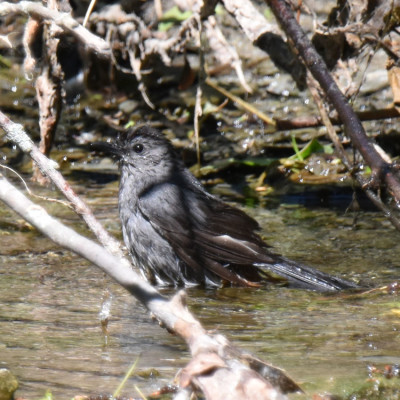
This Gray Catbird splashed around for a few minutes. It tried to protect itself by bathing almost underneath some overhanging branches. It then moved up into a thicket to preen and dry.
This Oriole was hunting in the bushes along the upper reaches of Sheridan Creek. I wasn’t sure whether it was looking for caterpillars or bees in the dogwood blossoms but it found something it liked. I’ve asked opinions and it seems likely it is a not-yet-fully-adult Orchard Oriole. The black growing in under bill suggests that, given its yellow colouring. I’m not an Oriole expert, though, so please leave a comment if I’ve been mis-informed. (The brilliant orange and black male adult Baltimore Orioles are much easier for me to recognize.)
Rattray Cooper’s Hawks Stuffed Full of Fluffy Chicks in late June
I’ve been trying to remember to check the Cooper’s Hawk nest each time I pass it this year. Having finally figured out where I can get a small line of sight to the nest even with the trees leafed out, I’ve been able to take photos and check later on the computer whether any raptor was staring back at me.
This time, I was able to see, even without my computer, that the nest is overflowing with white fluff. Since the nest is deep and eggs are always too far down to be seen, I knew it wasn’t nest stuffing, it was chicks!
As you can see in this very zoomed photo, taken from a great distance back and down from the nest, there are chicks in the nest. It was very difficult to tell how many, though. I could see two separate faces distinctly in several photos, and in one photo I think I can see three faces. If the birds did not move around in the nest, there may be as many as four or even five chicks…..but I was watching off and on for over 5 minutes, so the same birds may just have moved around. (I was hoping for a parent to arrive with food but one didn’t while I was there. On the other hand, the parent would probably have perched and blocked my entire view anyway.) The AllAboutBirds website says that 2-6 eggs are not uncommon.
I thought it looked weird to see the way the adult feathers are coming in along this wing. I didn’t realize how odd it would look to have adult flight feathers and white down at the same time.
I hope I remember to check the Cooper’s’ nest again the next time I’m down. Many raptors spend a few days practicing flapping their wings before they leave the nest and I might get a better idea of how many chicks there really are.
If not, there will always be something interesting to see!
(PS The Curious Caterpillar I saw earlier this month at the Rattray may be a Banded Hairstreak butterfly caterpillar.)
Related Reading
- The Joys of Early June: Black Swallowtails, Pink Fleabane, Nesting Fish and Curious Caterpillars
- A Great Egret Stalks Snacks at the Rattray Marsh
- A Rainy Day at the Rattray Marsh Brings Out the Birds
- Chickadees Excavating and Woodpeckers Chiseling
Join In
Do you look specifically for one type of creature when out for a prowl, or do you like to learn a bit about everything from rocks to gnats and back? Please share your views with a comment.

